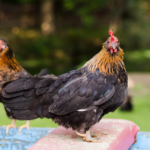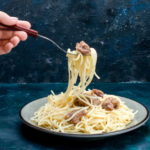Capellini, often referred to as “angel hair” pasta, is a delicate, thin strand of Italian pasta. With a thickness typically between 0.85 and 0.92 millimeters, capellini is finer than spaghetti and one of the thinnest types of pasta available. This light, airy pasta is favored for its versatility, quick cooking time, and its ability to absorb flavors and sauces. Its name is derived from the Italian word capello, meaning “hair,” aptly describing its fine and fragile structure. This article will explore the history of capellini, its place in Italian cuisine, its uses in various dishes, and tips for cooking it perfectly.
A Brief History of Capellini
Capellini’s origins trace back to Italy, like many other types of pasta. Italy, particularly the regions of Liguria and Campania, is known for its strong pasta culture, and thin pasta varieties like capellini were first documented centuries ago. Pasta itself has a long and rich history, with some claims dating back to the Roman Empire, where wheat was a staple crop. Over time, pasta-making techniques became more refined, leading to the creation of various shapes and thicknesses of pasta, each with its distinct purpose.
In its early days, capellini was often made by hand, rolled out into long, thin strands. The fragility and delicacy of this pasta meant that it required great skill to make. In certain regions of Italy, capellini was seen as a specialty pasta, often reserved for special occasions due to the difficulty of its preparation.
As industrial pasta production developed in the 19th and 20th centuries, capellini became more widely available, allowing people outside Italy to enjoy this fine pasta. Today, it is produced by numerous pasta manufacturers worldwide, both in its traditional form and as an ingredient in a wide array of Italian-inspired dishes.
The Origins of Thin Pasta
Capellini belongs to a family of pasta shapes that include other thin varieties like vermicelli and capelli d’angelo (angel hair). These types of pasta were especially popular in southern Italy, where they were traditionally served with light sauces or broths. The thinness of capellini was ideal for quick-cooking meals, which made it a favorite for many Italians, especially in busy households.
Thin pasta also had a symbolic value, often associated with grace and elegance due to its delicate nature. It was sometimes served at weddings or festive occasions to signify the tender, intertwined nature of marriage. Though it has now become more of an everyday staple, capellini’s fine texture still holds a special place in Italian culinary tradition.
Capellini in Italian Cuisine
In Italian cuisine, pasta is central to many dishes, and each type of pasta is paired with specific sauces or cooking techniques to highlight its characteristics. Capellini is no different. Its thin nature allows it to absorb flavors quickly, which is why it’s often paired with light sauces that cling to the strands without overwhelming them.
Capellini is most commonly used in primi piatti, or first courses. A simple dish of capellini tossed with olive oil, garlic, and a sprinkle of Parmesan cheese is a classic example of how the pasta’s simplicity can shine through. However, capellini is also frequently used in soups and broths, where its quick cooking time and light texture make it a perfect complement to delicate, broth-based dishes.
Popular Capellini Dishes
Capellini Pomodoro
One of the most well-known capellini dishes is capellini pomodoro. In this dish, capellini is tossed with a fresh tomato sauce made from ripe tomatoes, garlic, basil, and olive oil. This dish embodies the simplicity and freshness of Italian cuisine. The lightness of the capellini complements the tangy, vibrant flavors of the tomato sauce, creating a perfect balance. Often, a sprinkle of fresh Parmesan cheese or a drizzle of extra virgin olive oil is added to enhance the flavors further.
Capellini Aglio e Olio
Capellini aglio e olio is another classic, simple dish that showcases the beauty of minimal ingredients. In this preparation, capellini is cooked al dente and then tossed with olive oil that has been infused with garlic and red pepper flakes. This quick and easy dish is perfect for a weeknight meal or when you want something light but flavorful. The thin capellini strands absorb the fragrant olive oil, making each bite full of garlicky goodness.
Capellini with Seafood
Capellini pairs exceptionally well with seafood, as its delicate nature does not overshadow the subtle flavors of shellfish or fish. Dishes like capellini alle vongole (with clams) or capellini ai gamberi (with shrimp) are popular in coastal regions of Italy. In these dishes, the pasta is often tossed with a white wine and garlic sauce, which complements the briny flavors of the seafood without being too heavy.
Capellini in Brodo
Capellini in broth (brodo) is a classic comfort food, especially in Italian homes. The pasta is cooked directly in the broth, absorbing its flavors as it softens. This dish is often served as a light, warming soup, ideal for colder months or as a simple, nourishing meal. Chicken or vegetable broth is commonly used, and the dish can be garnished with freshly grated cheese, herbs, or a drizzle of olive oil.
Capellini Alfredo
Though Alfredo sauce is more commonly associated with fettuccine, it can also be paired with capellini for a lighter version of the classic dish. In this preparation, the fine strands of capellini are coated with a creamy, cheesy Alfredo sauce. The thinner pasta allows the rich sauce to cling to each strand without becoming overly heavy, making it a decadent but balanced meal.
Cooking Capellini to Perfection
Because of its thinness, capellini cooks much more quickly than other types of pasta. It typically only takes around 2-4 minutes to reach al dente texture. Overcooking is a common issue, as capellini can quickly turn mushy if left in the water for too long.
Here are a few tips to ensure perfectly cooked capellini:
- Use plenty of water: Capellini has a tendency to clump together as it cooks. Using a large pot of boiling water ensures that the strands have enough space to move freely.
- Salt the water: Adding salt to the boiling water is essential for seasoning the pasta from the inside out. A good rule of thumb is to add about 1-2 tablespoons of salt per pound of pasta.
- Watch the time: Since capellini cooks very quickly, it’s important to keep a close eye on the clock. Start checking for doneness after just 2 minutes of cooking. The pasta should be tender but still have a slight bite in the center.
- Drain quickly: Once the pasta is cooked, drain it immediately to prevent it from continuing to cook in the residual heat. You can also rinse it briefly with cold water to stop the cooking process if necessary.
- Toss with sauce quickly: Capellini can dry out and stick together if left alone for too long after cooking. To prevent this, toss it with your sauce or olive oil as soon as it’s drained.
Fresh vs. Dried Capellini
Capellini’s can be found in both fresh and dried varieties. Fresh capellini’s is typically even thinner than its dried counterpart and has a more delicate texture. It cooks in under 2 minutes and is often used in more refined dishes where the texture of the pasta is the star. Fresh capellini is commonly found in specialty Italian markets or can be made at home with a pasta machine.
Dried capellini’s, on the other hand, is more readily available and has a slightly firmer texture once cooked. It is ideal for dishes with sauces, as it holds its shape better than fresh pasta. Both types of capellini’s have their place in the kitchen, and the choice between fresh and dried often comes down to personal preference and the specific dish you’re preparing.
Capellini and Global Cuisine
Though capellini’s is deeply rooted in Italian tradition, it has also found a place in global cuisine. Its light texture and versatility make it suitable for a wide range of international dishes, and it can be adapted to many culinary styles.
Capellini in Asian Cuisine
Capellini’s similarity to thin Asian noodles, such as vermicelli or rice noodles, has made it a popular substitute in some Asian dishes. It can be used in stir-fries, soups, or even cold noodle salads, where its ability to absorb flavors makes it a great vehicle for sauces like soy sauce, sesame oil, and fish sauce.
One example is using capellini’s in a dish like Singapore noodles, where the pasta is stir-fried with vegetables, shrimp, and a curry-based sauce. The thin strands of capellini’s mimic the texture of traditional rice noodles but add a slightly different flavor and texture to the dish.
Capellini in Fusion Dishes
Capellini’s is also frequently used in fusion dishes, where Italian ingredients and techniques are combined with flavors from other cuisines. For instance, capellini’s can be paired with Mexican ingredients like avocado, cilantro, and lime for a fresh, light pasta salad with a Latin twist. Similarly, capellini’s can be tossed with Japanese flavors such as miso, seaweed, and soy for a unique East-meets-West pasta dish.
Capellini in Modern Gastronomy
In the realm of modern gastronomy, capellini’s has been experimented with in various ways. Its fine texture makes it ideal for creative plating and artistic presentations. Some chefs have used capellini in avant-garde dishes where the pasta is paired with unconventional ingredients like foams, emulsions, or molecular gastronomy techniques.
Nutritional Value of Capellini
Like most types of pasta, capellini’s is made from durum wheat semolina, which is high in protein and gluten. It is also a good source of carbohydrates, which provide energy for the body. One serving of capellini’s (about 56 grams, or 2 ounces) contains approximately:
- Calories: 200
- Protein: 7 grams
- Fat: 1 gram
- Carbohydrates: 42 grams
- Fiber: 2 grams
Capellini’s can be part of a balanced diet when consumed in moderation. It’s important to note that the nutritional value of a capellini’s dish will vary depending on the sauces and ingredients used. A light olive oil or tomato-based sauce will be lower in calories and fat compared to a creamy Alfredo sauce.
Whole Wheat and Gluten-Free Capellini
For those looking for healthier options, whole wheat capellini’s is available. Whole wheat pasta contains more fiber than traditional white pasta, which can aid in digestion and help you feel fuller for longer. It also has a slightly nuttier flavor and firmer texture.
Gluten-free capellini’s is also an option for those with celiac disease or gluten intolerance. Gluten-free versions are often made from rice, corn, or quinoa flour and can closely mimic the texture of traditional capellini’s. However, gluten-free pasta can sometimes have a slightly different mouthfeel, and it’s important to follow the cooking instructions carefully to avoid overcooking or undercooking.
Conclusion
Capellini’s, with its delicate strands and rich history, holds a special place in the world of pasta. From its origins in Italy to its global adaptation in various cuisines, this fine pasta continues to be cherished for its versatility, quick cooking time, and ability to complement a wide range of sauces and flavors. Whether served with a simple tomato sauce, tossed with seafood, or used in creative fusion dishes, capellini proves that sometimes, the most delicate ingredients can have the most profound impact.
As pasta lovers continue to explore new ways to enjoy capellini’s, it remains a timeless choice for those who appreciate the beauty of simplicity and the elegance of Italian cuisine. Whether you’re cooking a traditional Italian meal or experimenting with global flavors, capellini’s is a pasta that can elevate any dish with its light, airy texture and ability to absorb the essence of its accompanying ingredients.







